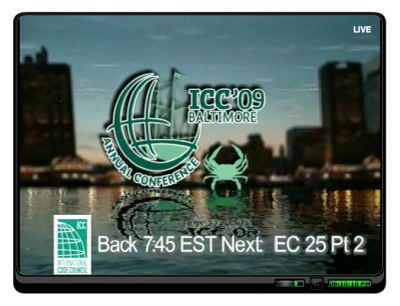
Livable Streets Get New Look from Fire Code Officials
Reform proposal wins partial approval at International Code Council hearing
Submitted on 10/26/2009. Tags for this image:
Warning: Table './archive_cnu/watchdog' is marked as crashed and should be repaired query: INSERT INTO watchdog (uid, type, message, variables, severity, link, location, referer, hostname, timestamp) VALUES (0, 'php', '%message in %file on line %line.', 'a:4:{s:6:\"%error\";s:7:\"warning\";s:8:\"%message\";s:39:\"Invalid argument supplied for foreach()\";s:5:\"%file\";s:100:\"/var/www/archive.cnu.org/htdocs/sites/cnu.civicactions.net/themes/cnu/node-content_news_item.tpl.php\";s:5:\"%line\";i:27;}', 3, '', 'http://archive.cnu.org/cnu-news/2009/10/livable-streets-get-new-look-fire-code-officials', '', '3.21.247.78', 1732651536) in /var/www/archive.cnu.org/htdocs/includes/database.mysql.inc on line 135
BALTIMORE – CNU’s proposed changes to the International Fire Code won a split decision from the International Code Council’s fire code committee, along with a clear invitation for more dialogue on street design between new urbanists and the fire service.
On Oct. 26, the committee rejected on a 9-4 vote the proposed code change to Section 503 of the fire code, the passage that currently mandates designated fire access roads have at least 20 feet of clear space (free of parked cars). The requirement can be a factor contributing to wider streets that signal to drivers to travel at faster speeds. If it had been accepted, CNU's proposed language change would have granted fire code officials flexibility to approve streets with less than 20 feet of clear space, depending on factors such as turning radii, connectivity, traffic safety, and the presence of sprinkler systems.
Despite dealing the reform team that setback, the committee overwhelmingly approved (12-1) our proposed Appendix K, which offers performance-based guidance to fire code officials on street designs and "… establish[es] requirements consistent with nationally and internationally recognized good practice for achieving a reasonable level of overall life safety, by taking into account and balancing the need to prevent road traffic deaths and injuries and the need to safeguard against the hazards of fire, explosions and other dangerous conditions."
For example, instead of a strict 20-foot-clear requirement Appendix K recognizes street widths and vertical clearances that permit “passage of the jurisdiction's fire apparatus and, wherever necessary, provides adequate space for deploying the jurisdiction's fire apparatus and for conducting fire and rescue operations.”
CNU’s proposals acknowledge that solid common ground exists for ongoing efforts to reconcile narrower streets and good emergency access: Street connectivity — specifically well-connected networks of traditional street grids — is essential to good urbanism, shortens emergency response times, and improves overall community life safety. Taken together, these changes would have made the fire code less focused on mandating wide streets, and more flexible in allowing cities to take advantage of the safety and response benefits of connected networks of walkable narrower streets. Even so, acceptance of Appendix K and the committee’s stated desire for more dialogue with CNU are important steps toward that goal.
CNU’s proposals were developed jointly with fire marshals participating in the Emergency Response & Street Design Initiative. Fire marshals Carl Wren, of the Austin, Texas, Fire Department, and Rick Merck, of Montgomery County (Md.) Fire & Rescue, co-authored the Section 503 amendment. CNU was represented by John Norquist, president & CEO; Jon Davis, project manager for the Emergency Response & Street Design Initiative, and Patrick Siegman, a transportation planner with Nelson\Nygaard, of San Francisco, who co-authored the proposed Appendix K. Danielle Arigoni spoke on behalf of the U.S. Environmental Protection Agency’s Smart Growth office, which is CNU’s partner in the Emergency Response & Street Design Initiative.
The fire code committee also unanimously approved another proposal, offered by the ICC’s Joint Fire Service Review Committee that states, “Traffic calming devices are prohibited unless approved by the fire code official,” and defines traffic calming devices as "…design elements of fire apparatus access roads such as street alignment, installation of barriers, and other physical measures intended to reduce traffic and cut-through volumes, and slow vehicle speeds." Read the full text here.
Proponents said they are not trying to take over, or dictate traffic safety engineering by approving this measure. Rather, they said, its goal is to ensure the fire service a seat at the street design and traffic engineering tables. “ Dialogue needs to happen, needs to start. This is it,” said committee member Joe McElvaney Jr., a fire protection engineer with the Phoenix, Ariz., Fire Department.
The committee's decisions here are preliminary. The ICC is seeking public comments through Feb. 8, 2010. Please submit comments supporting our proposals; MS Word and PDF comment forms are available here. The Final Action Hearings on proposed fire code changes will be held in 2010. Final decisions will then become part of ICC codes in 2011.
“I think we’ve had a very beneficial and productive discussion,” Carl Wren said. “It is by no means complete.”

